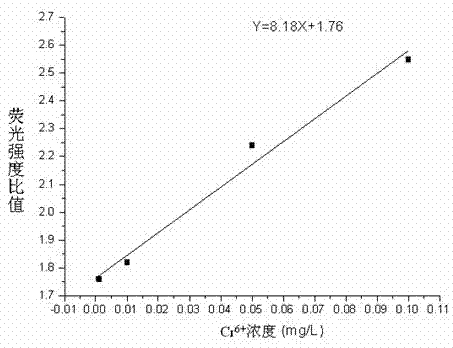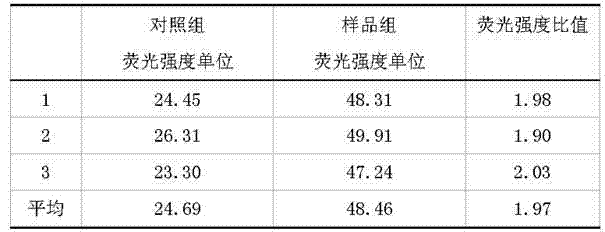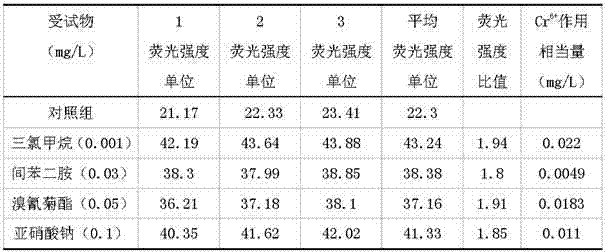Water quality genotoxicity detection method based on semiconductor opening switch (SOS) effect of recombinant Escherichia coli
A technology for recombinant Escherichia coli and Escherichia coli, which is applied in the direction of material excitation analysis, fluorescence/phosphorescence, etc., can solve the problems of high price, insensitivity of chlorinated organic substances, and difficult access to recombinant bacteria system, and achieves simple and easy cultivation and operation , Improve the sensitivity of fluorescence detection and reduce the effect of detecting fluorescence background value
- Summary
- Abstract
- Description
- Claims
- Application Information
AI Technical Summary
Problems solved by technology
Method used
Image
Examples
Embodiment 1
[0042] The application of the genetic toxicity biological detection method based on the SOS effect of recombinant E. coli in the detection of concentrated water samples (4L of water concentrated to 1mL) from a water plant, the steps are as follows:
[0043] (1) Resuscitation and activation of recombinant E. coli storage
[0044] Put 200μL of recombinant E. coli stock into 5mL modified LB liquid medium (tryptone 10g / L, yeast extract 2.5g / L, NaCl 10g / L). In addition, add glucose to account for 0.3% (W / V), add ampicillin to a final concentration of 50μg / mL, 30°C, and shake culture at 150rpm for 16-18 hours.
[0045] (2) Preparation before E. coli detection solution
[0046] Put the resuscitation solution into fresh modified LB liquid medium at a volume ratio of 1 / 100, shake culture at 35-37°C and 180 rpm, and cultivate until the OD (520nm) of the bacterial solution is 0.4 for about 2 hours.
[0047] (3) Contact with the tested sample
[0048] Add 100μL of the test sample to the prepared 1m...
Embodiment 2
[0062] The same method was used to detect the concentrated sample of the incoming water from the water plant in Example 1 (4L of water was concentrated to 1mL), and the ratio of fluorescence intensity was plotted against Cr 6+ Concentration standard curve, chromium ion concentration is used to express the water quality toxicity of the water sample. The difference is: when resuscitation, the culture temperature is 33℃, and the rotation speed is 180rpm; when preparing the detection solution, the rotation speed is 250rpm, and the culture is cultured to the OD (520nm) It is 0.3; when the water sample or chromium ion solution to be tested is in contact with the test solution, the amount added is 20% of the test solution volume, and the speed is 250rpm. After testing, the fluorescence intensity ratio of the water sample to be tested is 1.90, which is brought into the standard curve, and the genotoxicity of the water sample to be tested is equivalent to 0.0171 mg / L Cr 6+ The effect.
Embodiment 3
[0064] The same method was used to detect the concentrated sample of the incoming water from the water plant in Example 1 (4L of water was concentrated to 1mL), and the ratio of fluorescence intensity was plotted against Cr 6+ Concentration standard curve, the chromium ion concentration is used to express the water toxicity of the water sample, the difference is: the test solution after contact with the water sample or chromium ion solution is centrifuged at 10000rpm to separate the E. coli contact liquid for 2 minutes, and then broken by ultrasonic method The bacterial cells were broken by a program of 4 seconds, 4 seconds apart, and 15 times broken, and then the broken bacterial cells were centrifuged at a high speed of 14000 rpm for 8 minutes. After testing, the fluorescence intensity ratio of the water sample to be tested is 2.08, which is brought into the standard curve, and the genotoxicity of the water sample to be tested is equivalent to 0.0391mg / L Cr 6+ The effect.
PUM
 Login to View More
Login to View More Abstract
Description
Claims
Application Information
 Login to View More
Login to View More - R&D
- Intellectual Property
- Life Sciences
- Materials
- Tech Scout
- Unparalleled Data Quality
- Higher Quality Content
- 60% Fewer Hallucinations
Browse by: Latest US Patents, China's latest patents, Technical Efficacy Thesaurus, Application Domain, Technology Topic, Popular Technical Reports.
© 2025 PatSnap. All rights reserved.Legal|Privacy policy|Modern Slavery Act Transparency Statement|Sitemap|About US| Contact US: help@patsnap.com



